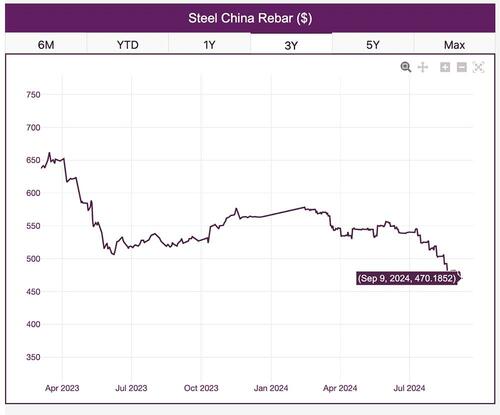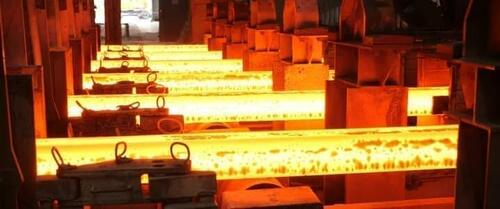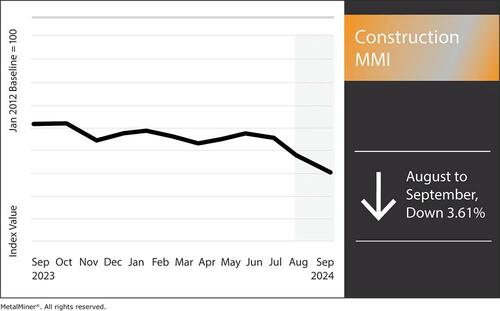Authored by Jennifer Kary for Metal Miner via oilprice.com,
The Construction MMI (Monthly Metals Index) broke further out of its sideways trend, dipping by 3.61%. The main culprits driving the index down month-over-month were falling steel rebar and h-beam steel prices, compelled by weak domestic demand within China. With China’s property sector not anticipated to strengthen in the short term, steel prices could continue to witness bearish pressure. This, in turn, could impact the steel and construction industries far beyond China’s borders.
H-Beam and Steel Rebar Prices Drop Amid Weak Chinese Demand
The global steel market took a turn over the past month as h-beam and steel rebar prices dropped in response to weakened domestic demand in China. This drop, a direct result of China’s ongoing construction slowdown and tightening restrictions on financing for real estate developers, continues to create ripple effects across global steel markets.
Slowing Demand, Sliding Steel Prices
China’s real estate sector, which accounts for a significant portion of steel consumption, witnessed a decline in new projects as government-imposed restrictions on developer financing weigh heavily on the market. This has significantly reduced demand for h-beam steel and steel rebar, essential components for heavy-duty construction.
For Chinese steel rebar, prices dropped by about 7% through August and early September. Meanwhile, the ongoing weak domestic demand is causing an oversupply situation that has spilled into global markets.
The h-beam steel market has experienced a similar downturn, with Chinese prices dropping approximately 7-8% from August to September. This, too, reflects the broader slowdown in infrastructure and construction in China’s property sector.
Global Impact of China’s Steel Slowdown on Steel Prices
China’s weakened steel demand continues to impact global demand as well. This is mainly because China is responsible for more than half of the world’s steel production. As Chinese suppliers flood international markets with excess steel products, other major economies are seeing downward price pressure on both h-beam and rebar steel.
This means that countries that rely heavily on steel imports are now witnessing price decreases in construction materials, which could benefit industries like real estate and infrastructure. However, this trend also risks creating imbalances in global trade. With the Chinese government showing no signs of loosening financing restrictions for developers, the construction sector is unlikely to see a rapid recovery.
 Source: MetalMiner Insights, which offers both short-term and long-term h-beam steel and steel rebar prices forecasts.
Source: MetalMiner Insights, which offers both short-term and long-term h-beam steel and steel rebar prices forecasts.Meanwhile, the outlook for steel rebar and h-beam steel remains similar. Without a clear resurgence in infrastructure projects within China, the oversupply of steel in the global market will likely persist, keeping prices low through the end of the year and further threatening domestic producers of steel in other countries, who can’t compete with such low prices.
U.S. Construction Industry Prepares for Anticipated Interest Rate Drops
The U.S. construction industry currently finds itself in a precarious, yet hopeful situation. For over a year, high interest rates set by the Federal Reserve have cast a shadow over the sector, dampening new residential and commercial projects and pushing developers to the sidelines. However, the anticipation of rate cuts—projected to begin in the latter half of 2024—recently sparked a wave of preparation across the industry.
For the past 18 months, high borrowing costs have slowed the pace of U.S. construction. As high mortgage rates deterred buyers, developers, facing skyrocketing financing costs, significantly scaled back on projects. In fact, construction spending fell for the first time in over a year in mid-2024, signaling a growing weariness across the industry.
The business sector endured the most hardship, as expenditures on retail stores, medical facilities, and offices declined. Meanwhile, the rising cost of mortgages discouraged both developers and potential homeowners, negatively impacting residential building.
The Fed’s Shift in Strategy
The construction industry is already adjusting its strategy in light of signals from Federal Reserve officials that interest rate reductions may start by late 2024. Builders are preparing to profit from a drop in borrowing rates, which could spur demand for residential and commercial real estate once again.
Still, project planning acceleration is one of the tactics. Many developers delayed starting new projects to wait for anticipated rate decreases that will lower the cost of financing, hoping to capitalize on the surge of fresh demand.
How Will Interest Rate Cuts Impact the Construction Industry?
The Federal Reserve’s decision to start cutting interest rates will behoove the construction sector in several ways. First, developers will find it easier to finance new projects as borrowing costs drop. Both residential and commercial building will probably see a resurgence due to this, especially in the housing industry, which suffered significantly under high borrowing rates.?
Also, lower interest rates in the commercial real estate market will make borrowing less expensive for companies wishing to grow or restore real estate. This would revive the market for commercial buildings, shopping centers, and industrial sites, reversing some of the declines seen in recent months. However, while interest rate cuts will undoubtedly have a positive impact, the recovery may not be immediate.
Source link



